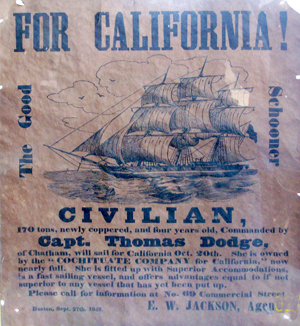Sea Captains: San Francisco 1800s
Thomas Dodge
Civilian, schooner (Cochituate Mining and Trading Company), from Boston, November 6, 1849, to San Francisco, April 5, 1850 (143 days).
Dodge, Thomas, master.
Editor's Note: On November 4, 2001, Angie Peters at acppp@aol.com, e-mailed the following information, which was taken from an old board found in a building about to be demolished:
FOR CALIFORNIA!
|
November 18, 1899, San Francisco Call, San Francisco, California
ANNIVERSARY DINNER BY PIONEER CALIFORNIAN
Captain Dodge, Now of Roxbury, Celebrates the Day of His Departure for this State.
BOSTON. No 17. Just fifty years ago last Sunday the little topsail schooner Civilian of only 165 tons burden and commanded by Captain Thomas Dodge of Chatham, sailed away from Fiskes Wharf for California. Her decks were crowded with men. Among them was Thomas Hayward, who now resides in Roxbury and who is one of the six of sixty passengers now known to be living. Today he celebrated the event by a dinner at his home in Rockville Park.
The voyage around the Horn to the Golden Gate occupied 143 days, including a stop for provisions and water. Mr. Hayward says that men were in such demand in San Francisco tha tthose who could merely saw off a board or drive a nail received $15 a day, and good mechanics received much larger wages. At that time the sandlots were covered with shanties and tents.
Mr. Hayward has been the treasurer for many years of the Society of California Pioneers of New England, and is always present at the monthly meetings, when the former gold-hunters of 1849 recall the dangers and the pleasures, the joys and the griefs, of long ago.

The Sea Chart
The Illustrated History of Nautical Maps and Navigational Charts
John Blake
The sea chart was one of the key tools by which ships of trade, transport and conquest navigated their course across the oceans. John Blake looks at the history and development of the chart and the related nautical map, in both scientific and aesthetic terms, as a means of safe and accurate seaborne navigation. This handsome work contains 150 color illustrations including the earliest charts of the Mediterranean made by thirteenth-century Italian merchant adventurers, as well as eighteenth-century charts that became strategic naval and commercial requirements and led to Cook's voyages in the Pacific, the search for the Northwest Passage, and races to the Arctic and Antarctic.
Maritime History as World History
(New Perspectives on Maritime History and Nautical Archaeology)
Daniel Finamore

Essays by leading scholars present an assessment of the field of maritime history in the early 21st century, offering insights into the impact of seaborne exploration, warfare, and commerce on the course of history, from the independent traditions of ancient Japanese, Arab, and Mediterranean seafarers to the rapid European expansion around the globe from the 16th century onward.
Author Daniel Finamore is Russell W. Knight Curator at the Peabody Essex Museum in Salem, Massachusetts.
The Authority to Sail: The History of U.S. Maritime Licenses and Seamen's Papers
Robert Stanley Bates, George Marsh (Editor), John F. Whiteley (Forward) (Batek Marine Publishing, 2011; Nominated in 2012 for a Pulitzer Prize)
This book depicts important aspects of our maritime history as a result of original research done by the author, Commodore Bates, the holder of an unlimited master's license who has enjoyed a distinguished fifty-year career in both the Coast Guard and the American Merchant Marine.
The U.S. Coast Guard issues all Captain Licenses for U.S. Ports.
Note: Other countries have different regulations, i.e. the RYA (Royal Yachting Association), conducts certification for Britain and Ireland. As of 2011, they did not recognize the USCG certification; certification through their courses was required.Master Unlimited is a licensed mariner in ultimate command of a vessel any gross tons. The captain is responsible for its safe and efficient operation, including cargo operations, navigation, crew management and ensuring that the vessel complies with local and international laws. All persons on board, including officers and crew, other shipboard staff members, passengers, guests and pilots, are under the captain's authority and are his or her ultimate responsibility. The STCW defines the Master as Person having command of the ship.
The Sea Chart
The Illustrated History of Nautical Maps and Navigational Charts
John Blake
The sea chart was one of the key tools by which ships of trade, transport and conquest navigated their course across the oceans. Herein is a history and development of the chart and the related nautical map, in both scientific and aesthetic terms, as a means of safe and accurate seaborne navigation. 150 color illustrations including the earliest charts of the Mediterranean made by 13th-century Italian merchant adventurers, as well as 18th-century charts that became strategic naval and commercial requirements and led to Cook's voyages in the Pacific, the search for the Northwest Passage, and races to the Arctic and Antarctic.
Get Your Captain's License. Fifth Edition
Charlie Wing
Considered the quickest, easiest, and least expensive way to prepare for the U.S. Coast Guard captain's ratings exams required for anyone who takes paying passengers on a boat, and useful for serious boaters who want to save money on insurance. 350 pages of seamanship and navigation tutorials. More than 1,500 questions and answers from the Coast Guard exams. Includes an interactive CD-ROM with all 14,000 questions and answers in the USCG database, so you can take an unlimited number of practice exams











 Copyright ~ 1998-2018.
Copyright ~ 1998-2018. 